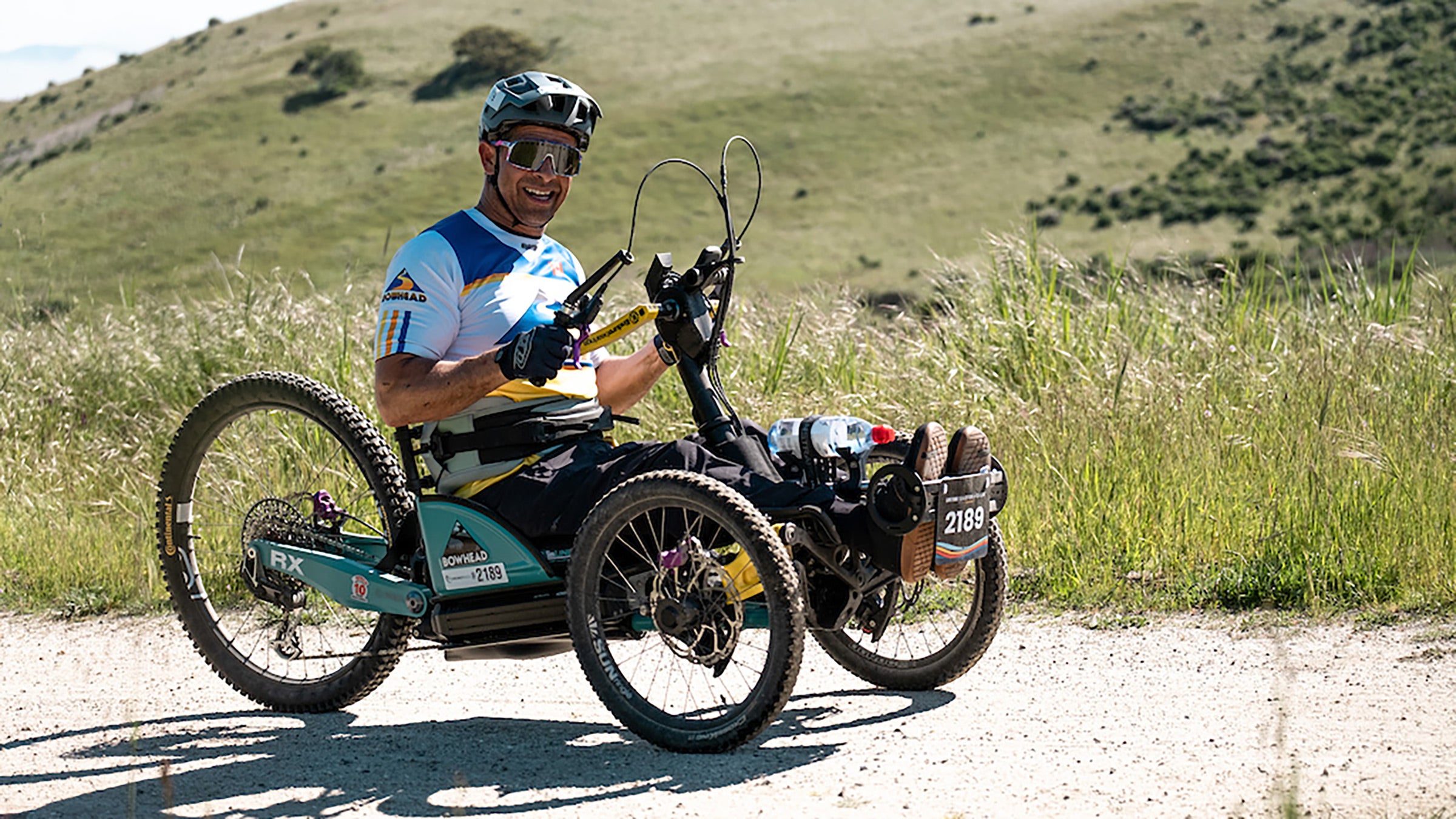My favorite segment in the 2023 film Nothing’s For Free: The History of Freeride Mountain Biking chronicles the improbable comeback story of German cyclist Tarek Rasouli. One of the pioneers of freeride in the mid-nineties, Rasouli suffered a terrifying crash in British Columbia in 2002 that left him paralyzed from the waist down and reliant on a wheelchair.
The injury did little to dull Rasouli’s ambition in the sport. In the decades that followed, he became one of the most influential figures in the mountain bike industry. Rasouli continued to make a name for himself, first as a magazine columnist and competition judge, and then as an event promoter and athlete manager. He also bought a handcycle and began road riding. These days, Rasouli operates the Red Bull District Ride, one of the biggest competitions in Slopestyle riding, and pedals his hand bike most days from his home in Munich. He was inducted into Mountain Biking’s Hall of Fame in 2022.
But 22 years after the crash, Rasouli’s comeback story continues. Just last week, he went mountain biking for one of the first times since his accident—he did it at California’s Sea Otter Classic cycling festival aboard an adaptive electric handcycle called the Bowhead RX Adventure. I reached out to Rasouli to hear about his his return to mountain biking, and was unsurprised when he told me that he had more than a few butterflies in his stomach before the ride.
“I was so nervous at the beginning, but also excited because I really didn’t know what to expect,” Rassouli told me. “There were so many times when the emotions really came up, but each time it was a real thrill.”
Rasouli signed up for the 50-mile gravel race at the Sea Otter Classic. The night before the race, he took the Bowhead on its maiden voyage, riding the dusty mountain-bike trails near the Laguna Seca auto racetrack alongside other icons of freeride mountain biking, like Richey Schley, Hans Rey, and Wade Simmons. He zipped up singletrack and bombed down the rutted, rocky trails—generally having a blast. During the ride, Rasouli says a lightbulb turned on in his brain. He pictured his life taking a new path by way of this new e-bike.
“This will mark a new chapter in life for me” Rasouli said. “Because it’s freedom, pure freedom. I’m free to ride with other people that also want to have fun on a bike and there are no big compromises anymore. They don’t have to wait for me.”
That ride marked one of many milestones for Rasouli on a bicycle. He told me that shortly after his injury he struggled to even look at a bicycle, let alone dream of riding one. As his recovery progressed, and he began working in the mountain biking industry again, he shrugged off riding a handcycle.
“I wasn’t too open to it because I was like ‘What is this thing? It’s not even a bike—it has three wheels,’” he told me. “I was like, I used to ride the most extreme terrain and jump off cliffs, and now I will ride on this thing?”
But he eventually did pedal one, and then he bought one, and then handcycling became an integral part of his life. These days he regularly completes four-hour adventures on his handcycle, pedaling it along the bike paths south of Munich.
Switching to an electric-assist bike is just another step in his journey. Over the past decade, electric-assist technology has steadily crept into the bike industry, and it has birthed dozens of innovative models that have helped people get rolling. You may have ridden one and marveled at how the boost of extra power impacts your daily commute, or your recreational trail ride. These days I pedal my kid to and from preschool aboard an e-cargo bike, and each year I see more kids and adults zipping by on them.
Pedal-assist is game-changing technology for getting adaptive athletes onto mountain bike trails, Rasouli told me. Adaptive off-road bikes have existed for years—there are recumbent and kneeling handcycles, bucket bikes and other designs that are built for the specific needs of an adaptive rider. But the steep gradients in mountain biking mean riders must pedal extremely large gears, which means they are often much slower than riders on traditional mountain bikes. Electric motors allow an adaptive rider to keep up, Rasouli said.
But it’s not easy. After each ride, Rasouli says his core muscles and chest are sore from riding the undulating terrain.
“I’m sitting upright and get to use my core a lot more on the mountain bike,” he said. “On a traditional handbike you only use your chest and shoulders and lats. Now, there’s a lot more work that goes on during a ride.”
Rasouli started the gravel race toward the back of the field and paced himself for the first of three 18-mile laps. He zipped along the dirt route and marveled at the bike’s traction on the loose corners. But the bike couldn’t handle all of the terrain—Rasouli said he had to be pushed up the steepest climb on the course. “Most people had to push their bikes up—I had a friend and she helped me,” he said. Another hitch happened when Rasouli forgot to change batteries after the midway point and had to wait on course for a new one to be delivered. After installing fresh power, he was back on his way.
After adjusting to the bike’s handling, Rasouli felt brave enough to attack one of the downhills. The thrill of descending on a mountain bike returned as he sped over ruts and rocks.
“At one point I rode downhill and my maximum was 46 miles per hour, I was just tucking and going down as fast as I could,” he said. “It felt so good.”

